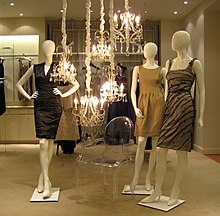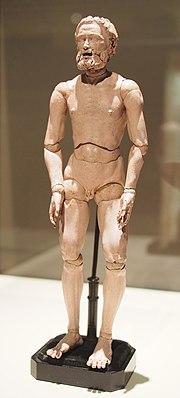Mannequin


Amannequin(sometimes spelled asmanikinand also called adummy,lay figure,ordress form) is adoll,often articulated, used byartists,tailors,dressmakers,window dressersand others, especially to display or fitclothingand show off differentfabricsand textiles. Previously, the English term referred to human models and muses (a meaning which it still retains in French and other European languages); the meaning as a dummy dating from the start ofWorld War II.[1]
Life-sized mannequins with simulatedairwaysare used in the teaching offirst aid,CPR,and advanced airway management skills such astracheal intubation.During the 1950s, mannequins were used innuclear teststo help show the effects of nuclear weapons on humans.[2][3]Also referred to as mannequins are the human figures used incomputer simulationto model the behavior of the human body.
Mannequincomes from theFrenchwordmannequin,which had acquired the meaning "an artist's jointed model", which in turn came from theFlemishwordmanneken,meaning "little man, figurine",[4]referring to late Middle Ages practice in Flanders whereby public display of even women's clothes was performed by male pages (boys). Fashion shops in Paris ordered dolls in reed from Flemish merchants. Flanders was in terms of logistics the easiest region to import reed dolls from, as the rivers Schelde and Oise provided easy routes from Flanders to Paris. As the Flemish wrote 'manneke(n)' for 'little man' on their invoices, the Parisians pronounced this as 'mannequen', hence shifted to 'mannequin'. A mannequin is thus linguistically masculine, not feminine.
History
[edit]Shop mannequins are derived fromdress formsused by fashion houses for dress making. The use of mannequins originated in the 15th century, when miniature "milliners' mannequins"were used to demonstrate fashions for customers.[5]Full-scale,wickerworkmannequins came into use in the mid-18th century.[5]Wirework mannequins were manufactured in Paris from 1835.[5]
Shop display
[edit]The first female mannequins, made ofpapier-mâché,were made in France in the mid-19th century.[5]Mannequins were later made of wax to produce a more lifelike appearance. In the 1920s, wax was supplanted by a more durable composite made with plaster.[6]
Modern day mannequins are made from a variety of materials, the primary ones beingfiberglassandplastic.The fiberglass mannequins are usually more expensive than the plastic ones, tend to be not as durable, but are significantly more realistic. Plastic mannequins, on the other hand, are a relatively new innovation in the mannequin field and are built to withstand the hustle of customer foot traffic usually witnessed in the store they are placed in.[7]

Mannequins are used primarily by retail stores as in-store displays or window decoration. However, many online sellers also use them to display their products for their product photos (as opposed to using a live model).[7]
Use by artists
[edit]Renaissance artistFra Bartolomeoinvented the full-scale articulated mannequin (more properly known as lay figure)[8]as an aid in drawing and painting draped figures. In 18th-century England, lay-figures are known to have been owned by portrait painters such asJoshua Reynolds,Thomas Gainsborough,andArthur Devisfor the arrangement ofconversation pieces.[9][10]
Medical education
[edit]Anatomical modelssuch as ivory manikins were used by doctors in the 17th century to study medical anatomy and as a teaching aid for pregnancy and childbirth. Each figure could be opened up to reveal internal organs and sometimes fetuses. There are only 180 known surviving ancient medical manikins worldwide.[11]

Today, medicalsimulationmannequins, models or related artefacts such as SimMan,[12]theTransparent Anatomical ManikinorHarvey[13]are widely used inmedical education.[14]The termmanikinrefers exclusively to these types of models, thoughmannequinis often also used.
Infirst aidcourses, manikins may be used to demonstrate methods of giving first aid (e.g.,resuscitation). Fire and coastguard services use mannequins to practice life-saving procedures. The mannequins have similar weight distribution to a human. Special obese mannequins and horse mannequins have also been made for similar purposes.
Over-reliance on mass-produced mannequins has been criticized for teaching medical students a hypothetical "average" that does not help them identify or understand the significant amount ofnormal variationseen in the real world.[15]
Representation in art and culture
[edit]
Mannequins were a frequent motif in the works of many early 20th-century artists, notably themetaphysical paintersGiorgio de Chirico,Alberto SavinioandCarlo Carrà.[16][17]
Shop windows displaying mannequins were a frequent photographic subject forEugène Atget.[6]
Mannequins have been used in horror and science fiction.The Twilight Zoneepisode "The After Hours"(1960) involves mannequins taking turns living in the real world as people. In theDoctor WhoserialSpearhead from Space(1970), an alien intelligence attempts to take overEarthwith killer plastic mannequins calledAutons.[18][19]
The romantic comedy filmMannequin(1987) is a story of a window dresser who falls in love with a mannequin that comes to life.[20]The romantic thriller filmBommai(2023) is the story of a person who works in a mannequin factory and falls in love with one of the mannequins, imagining it as his childhood crush.[21]
Military use
[edit]Military use of mannequins is recorded amongst the ancient Chinese, such as at thesiege of Yongqiu.The besieged Tang army lowered scarecrows down the walls of their castles to lure the fire of the enemy arrows. In this way, they renewed their supplies of arrows. Dummies were also used in the trenches in World War I to lure enemy snipers away from the soldiers.[22]
ACentral Intelligence Agency(CIA) report describes the use of a mannequin ( "Jack-in-the-Box" ) as acountersurveillancemeasure, intended to make it more difficult for the host country'scounterintelligenceto track the movement of CIA agents posing as diplomats. A "Jack-in-the-Box" – a mannequin representing the upper half of a human – would quickly replace a CIA agent after he left the car driven by another agent and walked away, so that any counterintelligence officers monitoring the agent's car would believe that he was still in the car.[23]
See also
[edit]- Agalmatophilia,sexual attraction to mannequins
- Crash test dummy
- Ivan Ivanovich- dummy used in Vostok spacecraft test flights
- Resusci Anne
References
[edit]- ^1902Pall Mall Mag.XXVII. 119 Another salon ornamented with tall mirrors in which were reflected the slender elegant figures of several mannequins, most of them exceedingly pretty and all arrayed in magnificent dresses...1939M. B. PickenLang. Fashion97/2 Mannequin model of human figure for display of garments, hats, furs, etc."mannequin".Oxford English Dictionary(Online ed.).Oxford University Press.(Subscription orparticipating institution membershiprequired.)
- ^"Nuclear Test Mannequins".Seattle Times Trinity Web.Seattle Times Company. 1995. Archived fromthe originalon 15 January 2012.
- ^Trivedi, Bijal P. (15 July 2002)."Archaeologists Explore Cold War Nuclear Test Site".National Geographic News.Archived fromthe originalon 18 August 2017.
- ^"mannequin".The American Heritage Dictionary of the English Language.Houghton Mifflin Company. 2004.Archivedfrom the original on 2009-08-10.Retrieved2009-08-07.
- ^abcdSteele, Valerie (ed.).Encyclopedia of Clothing and Fashion.Vol. 2. Detroit: Charles Scribner's Sons, 2005. p. 377
- ^abSteele, Valerie (ed.).Encyclopedia of Clothing and Fashion.Vol. 2. Detroit: Charles Scribner's Sons, 2005. p. 379
- ^abThe Mannequin GuideArchived2013-10-02 at theWayback MachineandThe Ultimate Visual Guide to Choosing the Right Mannequinby The Shop Company
- ^https:// oed /dictionary/lay-figure_n?tab=meaning_and_use#39517536[bare URL]
- ^Polite Society by Arthur Devis,Harris Museum and Art Gallery, Preston, 1983, p.67
- ^"lay figure".Oxford Reference.Retrieved2024-03-08.
- ^Jennifer Ouellette (27 Nov 2019)."CT scans confirm 17th-century medical mannikins are mostly made of ivory".ars Technica.Archivedfrom the original on 30 November 2019.Retrieved30 November2019.
- ^"SimMan".Laerdal.Archivedfrom the original on 2006-12-30.Retrieved2007-01-13.
- ^"Harvey: Major Changes".Gordon Center for Research in Medical Education.Archived fromthe originalon 2007-03-28.
- ^Cooper Jeffery B, Taqueti VR (December 2008)."A brief history of the development of mannequin simulators for clinical education and training".Postgrad Med J.84(997): 563–570.doi:10.1136/qshc.2004.009886.PMC1765785.PMID19103813.
- ^Jacobson, Ella (20 May 2019)."Too Human".Real Life.Archivedfrom the original on 2019-05-27.Retrieved2019-05-27.
- ^Holzhey, Magdalena. 2005.Giorgio de Chirico 1888–1978 the modern myth.Koln:Taschen.pp. 42–43.ISBN3-8228-4152-8
- ^*Cowling, Elizabeth; Mundy, Jennifer. 1990.On Classic Ground: Picasso, Léger, de Chirico and the New Classicism 1910-1930.London: Tate Gallery. p. 54.ISBN1-85437-043-X
- ^"Spearhead from Space".BBC.Archived fromthe originalon 2 May 2015.Retrieved21 April2015.
- ^Mulkern, Patrick (14 September 2009)."Spearhead from Space".Radio Times.Archivedfrom the original on 27 April 2015.Retrieved21 April2015.
- ^McQuade, Dan (4 December 2013)."Why Mannequin Is the Best Movie Ever Made About Philadelphia".Philadelphia.Archivedfrom the original on 7 March 2018.Retrieved21 April2015.
- ^"Bommai Movie Review: Another psycho act by SJ Suryah in a film that's a treasure trove of cliches".India Today.16 June 2023.Retrieved15 July2023.
- ^"List of strategies".Archived fromthe originalon 2012-10-27.Retrieved2012-10-27.
- ^Royden, Barry G. (2003),"Tolkachev, A Worthy Successor to Penkovsky. An Exceptional Espionage Operation",Studies in Intelligence,47(3), archived fromthe originalon June 13, 2007
Further reading
[edit]- The Recycling and Reuse of Mannequins -See 'Mannakin'
- Gross, Kenneth -The Dream of the Moving Statue(Penn State Press1992,ISBN0-271-02900-5)
- Verstappen, Stefan. The Thirty-six Strategies of Ancient China. 1999.
